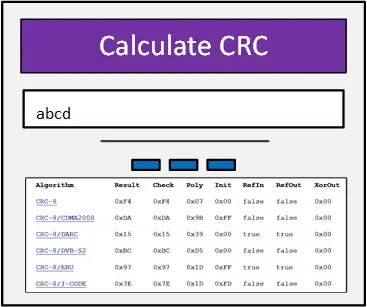Online CRC Calculator
CRC stands for cyclic redundancy check, and it is an error-detection code that is used to identify data corruption. Calculate your CRC with our Online CRC Calculator.
| Algorithm | Result | Check | Poly | Init | RefIn | RefOut | XorOut |
|---|
Please enable JavaScript on this site or click one of the buttons above.
Share your result:
 CRC is a channel coding mechanism that generates a brief fixed-digit check code based on network data packets or computer files. It's mostly used to discover or verify potential mistakes after data transmission or storage. To detect faults, it employs the division and remainder principle. CRC8, CRC16, CRC32, and CRC64 may all be calculated online with this tool.
CRC is a channel coding mechanism that generates a brief fixed-digit check code based on network data packets or computer files. It's mostly used to discover or verify potential mistakes after data transmission or storage. To detect faults, it employs the division and remainder principle. CRC8, CRC16, CRC32, and CRC64 may all be calculated online with this tool.
How can I use Online CRC calculator to calculate Checksum?
The computing algorithms for CRC-8, CRC-16, and CRC-32 are comparable. Pad the input by n bits and line it with the n-bit divisor depending on the polynomial of choice to compute an n-bit binary CRC. Then, by putting the n-bit divisor below the initial 1 in the input, repeatedly divide the data by the divisor. This is essentially bitwise XOR, with the bits not above the divisor remaining intact at each iteration.
When the divident equals zero, the CRC procedure terminates, leaving a residual of precisely n bits. This is eight bits for CRC-8. CRC-16 and CRC-32 each have 16 bits and 32 bits, respectively.
Application of the CRC Checksum Algorithms,
CRCs, such as CRC-32, are frequently used to ensure that no mistakes occurred during data transfer, and they perform well for typical communication channel problems. A checksum is a simple and acceptable way to ensure the integrity of communications sent.
CRC computations are similar to binary long division, with the exception that the subtractions do not borrow from more significant digits, making them exclusive operations (XORs). These operations are executed in hardware via bit-shifting and XORing, making them exceedingly efficient when done by hand.
CRC-8, CRC-16, CRC-32, and CRC-64: What's the Difference?
The generator polynomial is the most crucial aspect of the CRC algorithm implementation. The polynomial should be selected to optimize error detection while lowering total collision probabilities.
Because of its direct impact on the length of the computed check value, the polynomial's length (highest degree (exponent) +1 of any one term in the polynomial) is the most essential feature. The following are the most regularly used polynomial lengths:
- 9 bits of data (CRC-8)
- 17 bits of data (CRC-16)
- 33 bits of data (CRC-32)
- 65 bits of data (CRC-64)